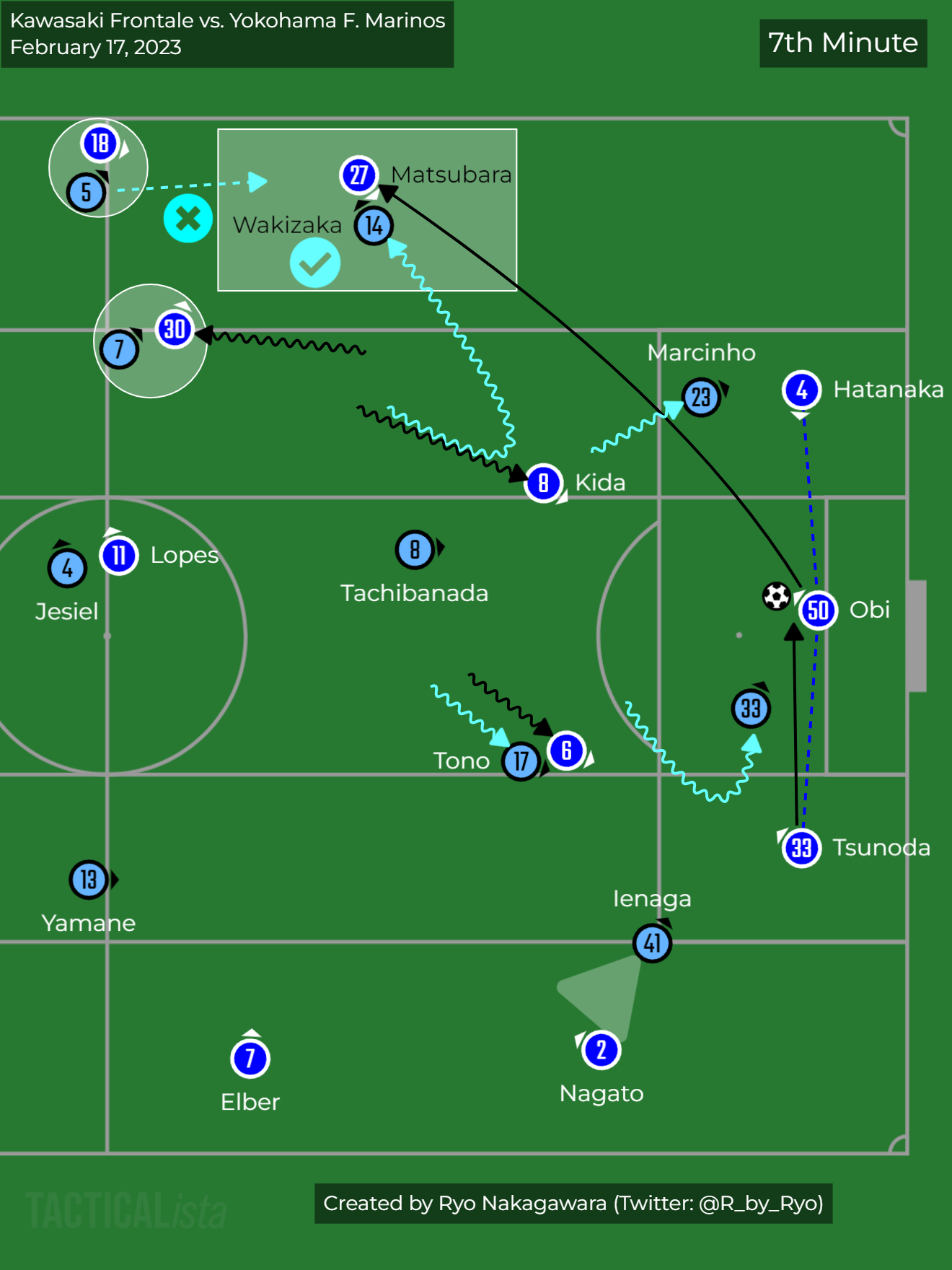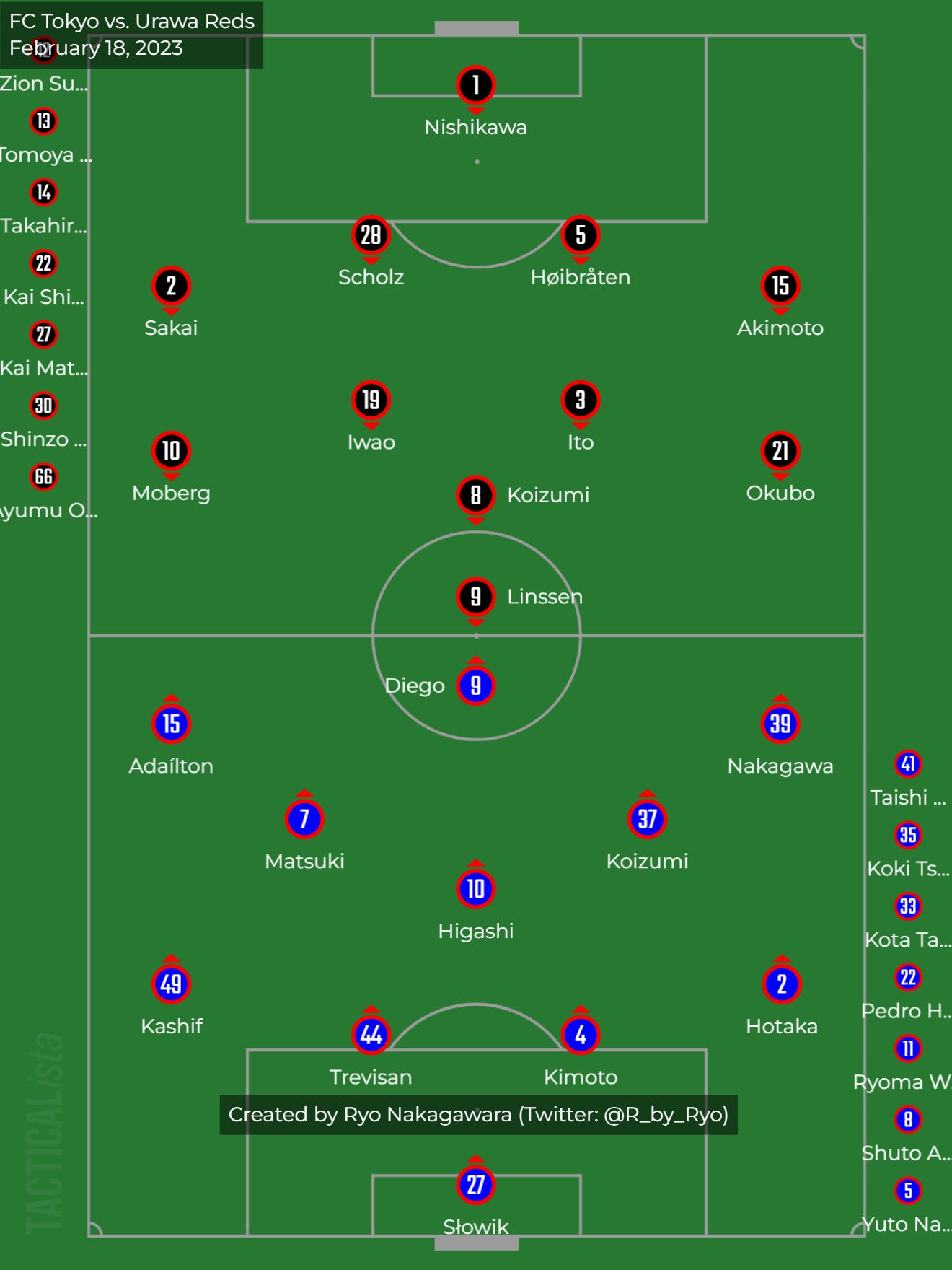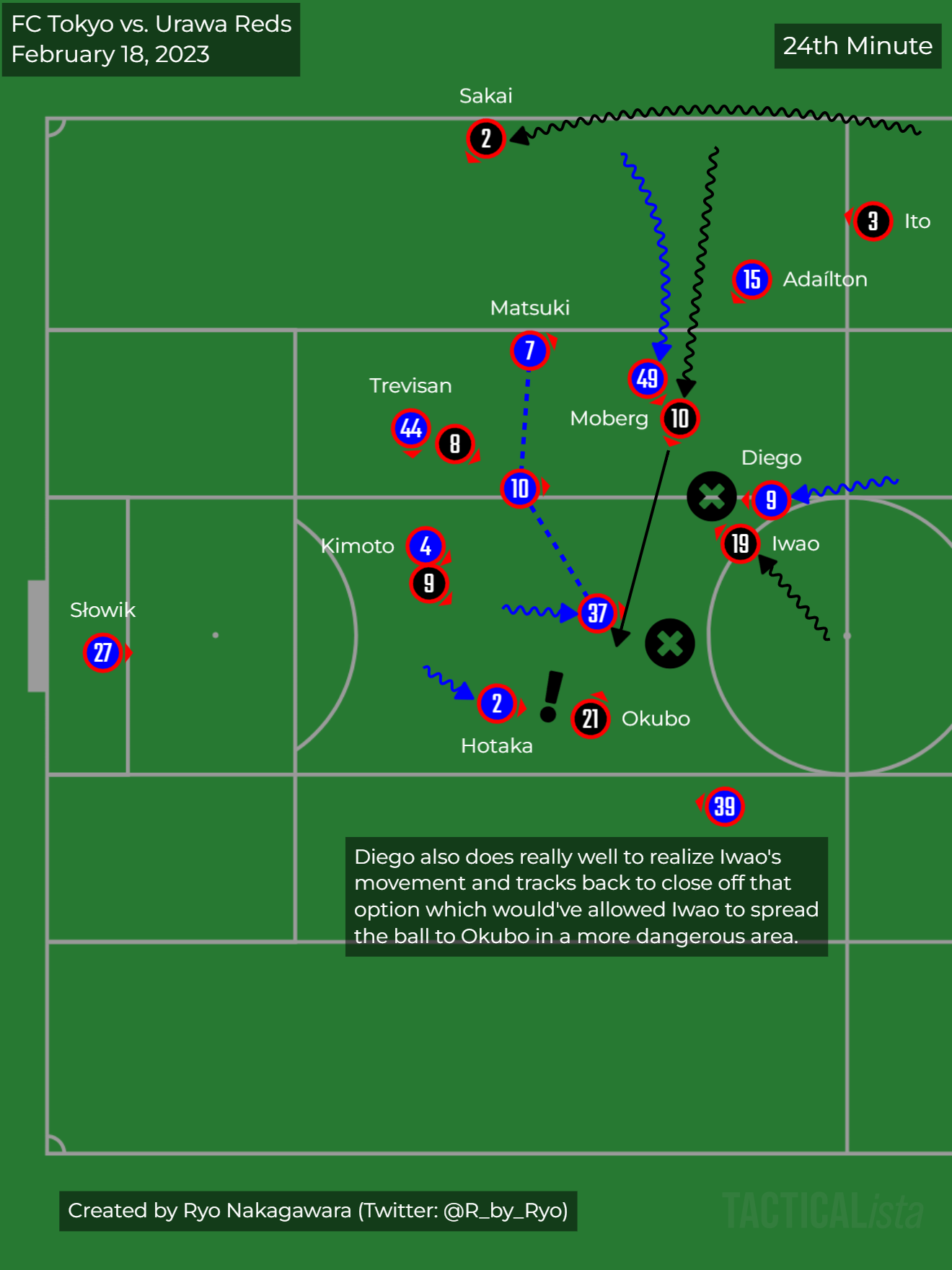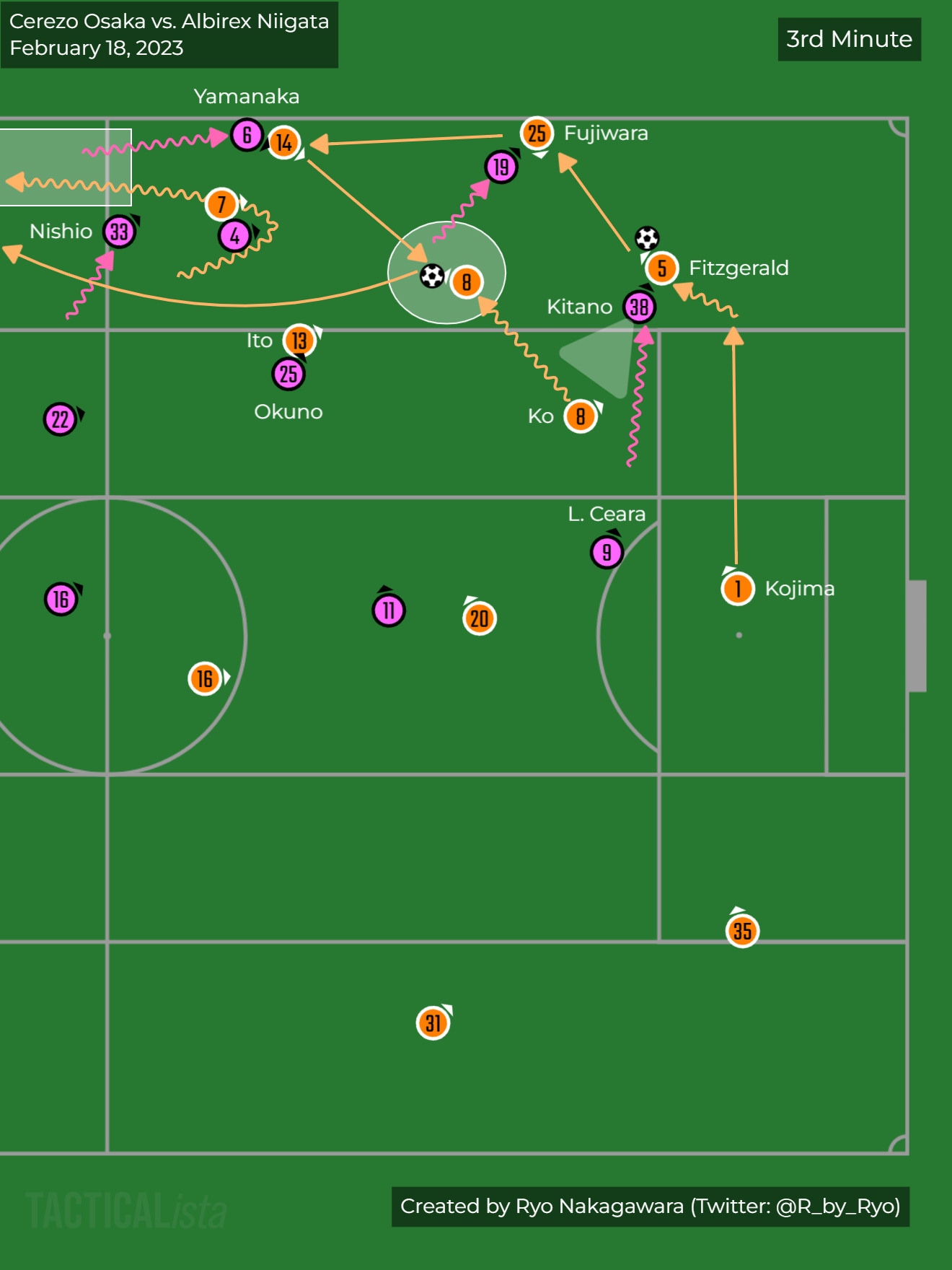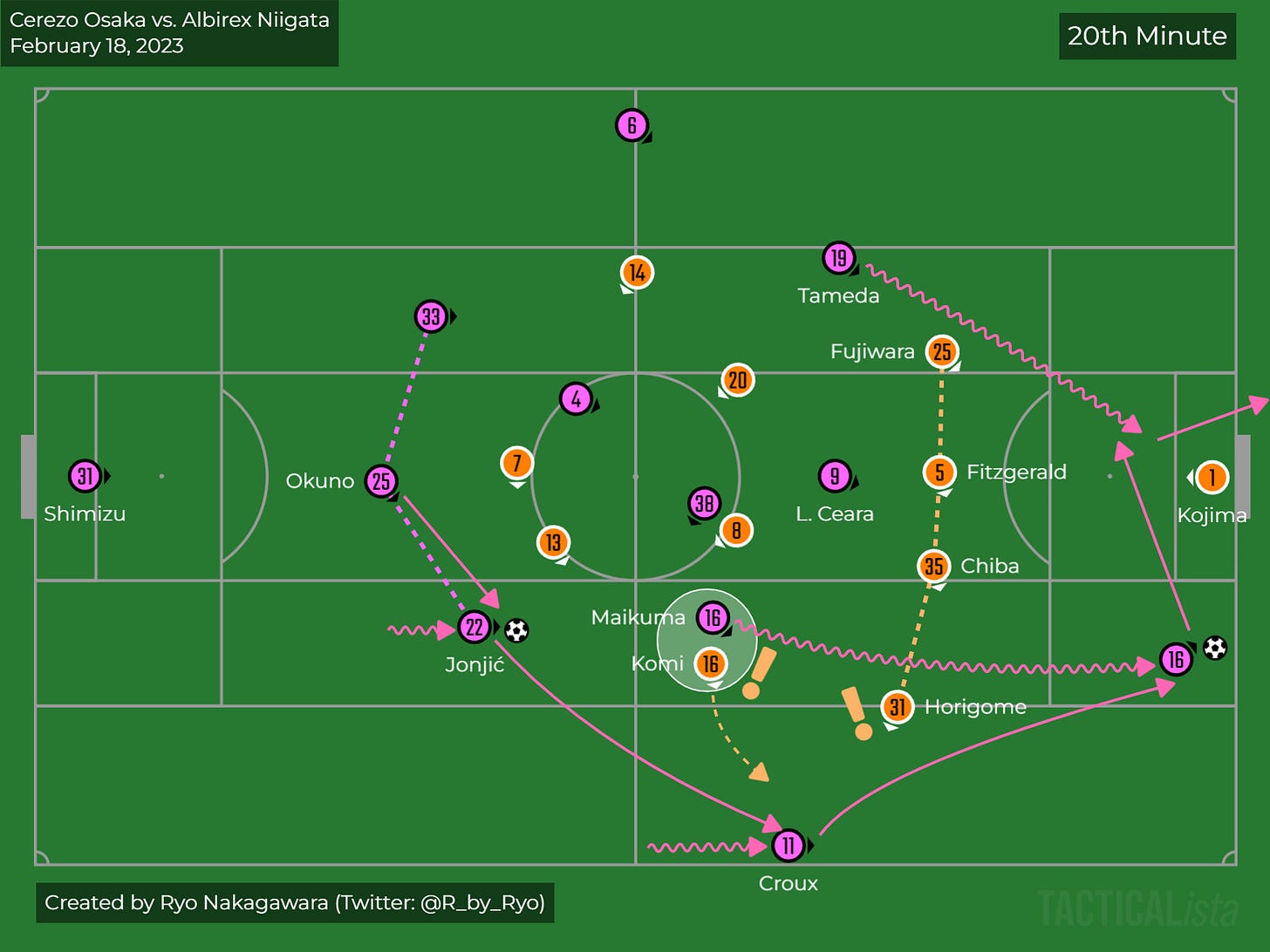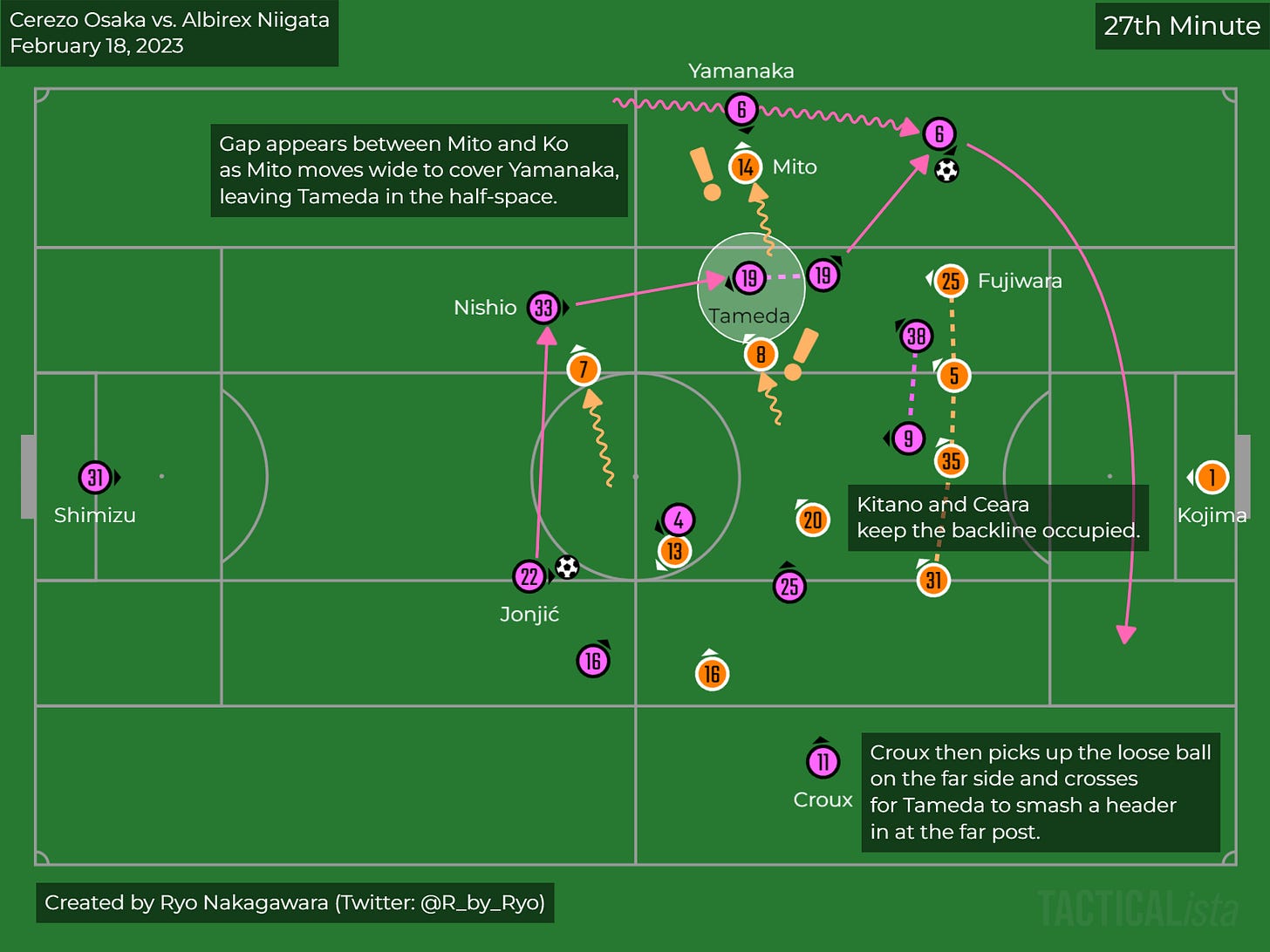J.League 2023 Matchday 1, Tactical Review: Kawasaki Frontale vs. Yokohama F. Marinos, FC Tokyo vs. Urawa Reds, & Cerezo Osaka vs. Albirex Niigata
New season, new ideas or same old tried-and-tested?
Hello and welcome to a new J.League season!
To celebrate and work off that new season adrenaline rush, I wrote up a couple of match reviews from a tactical perspective. I’ve usually not done something like this, preferring to write a very broad overview of every team… but new season, new challenges, let’s goooo, so let’s see what I can do. These tactical review type newsletters will consist of one-to-three matches, that is if I even do one at all. Please don’t expect them every single week but for me it’s a nice way to expand on my match notes so I may do this regularly instead of tweeting giant re-watch threads.
Let’s get started!
Kawasaki Frontale vs. Yokohama F. Marinos
Starting line-ups:
Ken Matsubara was back fit to return at Right Back meaning Kamijima was benched in favor of the same Hatanaka-Tsunoda Center Back pairing we saw in the Super Cup.
With Yu Kobayashi and Leandro Damiao still missing, Taisei Miyashiro started up top as expected.
Joao Schmidt was a surprise absence but made the bench (just recovered from a minor injury perhaps?) which meant Kento Tachibanada played as the single pivot and Daiya Tono came in as one of the box-to-box #8s.
Otherwise it was the usual line-ups we’ve seen from both teams in the past.
First Half:
Marinos pressed in a 4-4-2 with Nishimura and A. Lopes pressing the Center Backs while keeping track of Tachibanada behind them with their cover shadows. If Tono dropped, Kida would follow whereas Kota Watanabe followed Wakizaka deeper towards Frontale’s goal. Marinos’ Full Backs would follow their respective wingers up the field and the Center Backs were very aggressive in dealing with long balls to Taisei Miyashiro as well, so Marinos as a team were pushing up high against Frontale and keeping themselves vertically compact. One such moment led to the opening goal as Jung S.R. was put under pressure and his pass to Yamane was mis-kicked and Elber was able to get a head on it.
Frontale pressed in their usual 4-3-3 shape with their wingers trying to cut out the pass options between the Center Backs and Full Backs but Marinos used Obi to evade this as he could just chip it over Frontale’s wingers to the Full Backs (2:11, 3:01, 21:17). This is usually how teams are able to evade Frontale by aiming for this gap between Frontale’s winger and Full Back. Usually, one of the box-to-box midfielders will spring out to press or the Full Back would push up but that wasn’t always the case here as they were preoccupied by other Marinos players and couldn’t get to the Marinos Full Backs in time. Once the ball went wide, one of the Marinos Center Midfielders (Kota Watanabe especially) would position themselves between the lines to receive the ball and they were able to progress up the field quickly from there. Or like in the below graphic, Takuma Nishimura could pull players out of the center and create space for Anderson Lopes to make dropping movements. There wasn’t a whole lot of the usual Marinos Full Backs inverting as Central Midfielders as Katsuya Nagato usually stayed wide switching between the half-space and the wing with Elber while Matsubara only occasionally occupied central areas.
Still, when Frontale’s players were able to reach Marinos players in time, like Yasuto Wakizaka on Matsubara in the 7th minute or on Takuya Kida in the 27th minute, Frontale were able to keep Marinos penned into their defensive 3rd and potentially counterattack.
Despite all the pre-season talk of wanting to use Yamane in a fluid role in the build-up, Frontale started off with their usual 4-3-3 with Wakizaka, more than Tono, dropping deeper as a passing option for the Right sided Center Back, Full Back, and Tachibanada. There were times like in 5:20 where Frontale had Akihiro Ienaga drop very deep on the Right and they were able to play quick combinations to evade Marinos’ press and leave the Left wing open (and even in this case a poor cross-field ball from Yamane meant it was all for naught) and also in the 11th minute where Wakizaka was able to flick it on to Yamane for Frontale to progress up the field in a nice sequence but otherwise they were trapped along the sidelines and had to throw the ball away to Taisei Miyashiro, who just doesn’t have the kind of aerial and hold-up ability as someone like Leandro Damiao. Indeed, trying to play it long backfired as Marinos were able to win the ball in central areas such as in the 15th minute when Kota Watanabe was quickest to a loose ball after Tsunoda forced Miyashiro off the ball to quickly launch a dangerous counter themselves like for Anderson Lopes’ missed header chance.
Miki Yamane starts to invert
As Frontale’s build-up was continuously impeded, Miki Yamane finally started to come inside to sit next to Tachibanada as a central midfielder. Initially starting out wide, Yamane wasn’t a passing option due to Elber’s cover shadow but timing his movement inside allowed him to receive the ball. From here, Frontale could quickly combine to get the ball up-field as Tachibanada could now receive the ball facing forward. In the 18th minute shown below, both Miyashiro and Wakizaka’s movements then pulled the Marinos Center Backs past the half way line and created ample space for Daiya Tono to run into for Asahi Sasaki’s wonderfully weighted through ball.
Also see the scene in the 22nd minute where Yamane was able to attract Nishimura away from Tachibanada and they were able to play past Marinos’ forward and midfield lines to get the ball out wide for Marcinho to create a chance for Wakizaka. If Yamane was given time on the ball, he was able to look up and play some good diagonal passes to both Marcinho and Ienaga, providing a quick route into Marinos’ half, if not final 3rd.
They didn’t constantly do this which kept Marinos guessing like how only a few minutes later in the 26th minute, Frontale went back to their usual build-up pattern with Wakizaka receiving after dropping next to Tachibanada. On the other hand this meant Ienaga was pretty isolated, not being able to get the ball deeper but also in the final 3rd. One of the few exceptions to this was in the 29th minute when Yamane split the Center Backs like a #6 and played a diagonal ball wide to Ienaga with Wakizaka in close support to provide a run between Marinos’ Center Back and Full Back on the Right Wing. It did become pretty clear though by the end of the half that Yamane coming inside was the only clear and somewhat consistent way to getting the ball up the field as otherwise, Nishimura or A. Lopes could simply keep track of Tachibanada while the other chased Jung S.R. and the Center Back, while the Winger shut down the passing lane out to the Full Back. Occasional flick-ons from Wakizaka or even Ienaga came to naught as Miyashiro was hounded by Ryotaro Tsunoda and Kota Watanabe was always there to join in or pick up the loose ball (41:40, 41:58).
There were more than a few occasions where Marcinho was able to threaten behind Marinos’ high-line but Matsubara was usually equal to it and Shinnosuke Hatanaka and others were also able to make it across to cover behind in time as well. Marinos also weren’t afraid of playing it long as they had Anderson Lopes able to settle the ball (like Tsunoda to Lopes in the 57th minute) or there were occasions such as in the 44th minute where Nishimura dropped to the Right side (again, in that gap between Frontale’s Winger and Full Back) to pick out a long diagonal ball to Elber in the Left half-space which led to a decent chance that was suppressed by good defensive effort from Jesiel and Jung S.R. to close down the angle.
At the end of the 1st Half also presented a scene where Marinos’ high press faced issues. In the 46th minute, Kida had followed Ienaga dropping but Marinos weren’t able to stop Frontale from progressing the ball up the Left side. The ball eventually reached Tono in between Mizunuma (Right Wing) and Matsubara (Right Back), a large gap appearing as Kota Watanabe was alone and central which left this area very open for exploitation. Still, the fact that Marinos’ back 4 was actually sat back deeper than usual also meant that they had the numbers advantage despite the threat posed by Marcinho and Tono as they advanced toward the box.
2nd Half
There was one change at Half Time as Yusuke Segawa came on to make his debut in the place of Akihiro Ienaga.
Frontale created the first chance right after kickoff as Marinos were stretched very far apart vertically with a large gap between their front two (Nishimura and A. Lopes) and the midfielders behind them (Kota and Kida) which allowed Tachibanada to receive in acres of space from the Center Backs to play a forward ball to the wing. From there, the usual pattern of Yamane receiving in the half-space to then play a cross into Marcinho on the back post created a very dangerous set of chances that Frontale should’ve capitalized on. Marinos then had a chance of their own through a fast-restart (this will happen again later…) as Tsunoda lobbed a pass behind Jesiel to A. Lopes, the Brazilian striker’s shot from a tight angle trickled past the post.
Miki Yamane shifted centrally again to good effect in the 49th, 56th, and 61st minutes, which led to threatening opportunities but crucially, didn’t lead to actual shots on goal.
Yusuke Segawa made himself useful from early on as he simply stayed out wide and made sure Marinos had to spread themselves out to cover the entire width of the pitch, he took a tame shot after cutting inside as well as a decent cross to the far post in the first 10 minutes of his debut. Segawa continuously kept himself open as an option on the Right Wing which let Frontale spread the ball across far easier than in the 1st Half and made Marinos have to run a lot more from side-to-side (59 and 60th minutes). Overall, a decent debut but lacking that combination play you usually get to see on Frontale’s Right Flank in tandem with Wakizaka and Yamane. Of course, it’s a bit mean to compare since this is more a complement to how good Ienaga has been there for the past near-decade. I imagine that Segawa will develop that chemistry with his teammates over time.
Marinos press started to falter a bit as the half went on and Frontale were able to keep the ball more with Wakizaka in particular being able to face forward on the ball a lot more compared to the 1st Half. On the Left, Asahi Sasaki put in a lot of work as he had to both help out in the build-up as well as support Marcinho on the Left Wing. Despite going a man-down due to Jesiel’s red card, Sasaki soldiered on and was rewarded as Kenta Inoue’s slip allowed him to receive Schmidt’s lofted ball in the box to cut it back to Tachibanada on the far side for Frontale’s goal.
Summary:
Marinos will be disappointed that they couldn’t keep a clean sheet despite defending well for the most part as Hatanaka and Tsunoda formed a very good partnership and kept their high-line all throughout the game without being intimidated by Marcinho’s speed in-behind. This allowed Marinos to compress the pitch and restrict the spaces available for Frontale to play in for most of the game. Kota Watanabe was a contributor to that from midfield through his aggression in contesting the ball in midfield and being quick to pick up loose balls, while in the build-up he also provided a passing option to the defenders.
Frontale would rue not taking their golden chances when they were able to surprise Marinos with Yamane’s movement inside. Neither were they able to take advantage through their usual set-pieces during the times when Marcinho and Sasaki combined well to earn Frontale free kicks or corners. I think it was good that Kawasaki Frontale were actually trying out different things especially against as difficult of an opponent like Yokohama F. Marinos. It will be frustrating that they conceded so cheaply while trying to play this way but now having actually tested different strategies against league opposition, this should help them iron out their remaining weaknesses and evolve as a team. Taisei Miyashiro had a hard time up against Tsunoda who was excellent at not letting him turn with the ball but he still had a few bright moments and that bodes well for the near future as he’ll likely continue as the main striker for the next few months. In the post-match interview Miki Yamane was talking about how his new role in the build-up was a different kind of challenge and one that is quite physically taxing due to all of the extra movement and things to keep in mind. With Kurumaya’s injury and Jesiel’s straight red card it will be a tough few fixtures for Frontale. I imagine Yamamura and Ominami will start and at worst, they can have Joao Schmidt fill in as well.
Yokohama Marinos will face Urawa Reds next week while Kawasaki Frontale will play another difficult fixture against Kashima Antlers.
FC Tokyo vs. Urawa Reds
Here are the notes I took while watching the match:

Starting Line-ups:
Masato Morishige is reportedly injured so Henrique Trevisan played for the first time since late April 2022 after a long injury lay-off of his own.
As per pre-season reports, Keigo Higashi retained his spot as the single-pivot with Kei Koizumi as one of the box-to-box midfielders instead.
“Like a new signing” Bryan Linssen started up top while “actually a new signing” Marius Hoibraten started alongside Alex Scholz in defense.
Probably the only real surprise was that Takahiro Akimoto started at Left Back over Ayumu Ohata…?
First Half
All around this was a very intense game, especially in the 1st Half as both sides pressed, fought for every ball, and the resulting transitional moments tested player’s abilities to switch tracks. This was seen from the first 30 seconds of the game where Iwao won the ball in midfield, passed it to Ito who immediately played a through ball for Bryan Linssen between the Tokyo Center Backs. The ball eventually found itself to Moberg cutting inside from the Right and took a shot. Linssen was judged to have been offside from the initial ball but this was indicative of how Urawa looked to attack FC Tokyo throughout the First Half. Tokyo were also aggressive and only moments later, they would win the ball in Urawa’s half from a poor clearance and even when Urawa were able to regain the ball Kuryu Matsuki hounded Moberg near the corner flag and won Tokyo a free kick.
FC Tokyo defended with their wingers tucked in a fair bit, blocking the path between the Urawa Center Back and Full Back, hoping to force vertical passes centrally where Tokyo’s physically aggressive midfielders could intercept or win the ball off of Urawa midfielders dropping to receive. FC Tokyo weren’t always successful with this and allowed Urawa to be able to play central-then-wide (CB > CM > FB) but Urawa on the other hand didn’t really have a means to move forward after this so couldn’t take advantage other than a few occasions like in 39:00 and 43:40 when Hiroki Sakai was able to face forward on the ball as space was left behind Adailton.
Urawa defended as a 4-4-2 with Yoshio Koizumi moving up alongside Linssen to press the Tokyo Center Backs, in 7:45 Koizumi’s pressure (and a poor first touch from Kimoto) resulted in Okubo intercepting Kimoto’s rushed pass forward to counter attack ending in a free kick right outside the box. A lot of their good opportunities throughout the half came from short counters from their pressing (15:26, 18:57) and long balls (like Nishikawa to Okubo in the 11th minute) over Tokyo’s high line. It still remained a problem from last season that Urawa found it hard to actually break down teams in the defensive 3rd mostly relying on easily track-able overlaps and crossing (24:18, 32:30, 35:02, 37:10). Their best chances were quick attacks (like the one at the beginning of the game but also another at 38:00 and both ended up being flagged for offside. A common factor in most things Urawa did well was Yoshio Koizumi, who drifted around to find pockets of space to good effect like in 42:10.
As was the case for FC Tokyo last season, they still struggled in the build-up when trapped along the sidelines (see many examples from my season preview or the 2022 season review) as Hotaka Nakamura came under heavy pressure from Urawa (3:30, 9:20) resulting in short counters, Urawa midfielders cutting out vertical passes, or Urawa regaining possession from long balls forward that were usually won by the Center Back duo of Scholz and Hoibraten. FC Tokyo, as has been the case for many years, relied on Diego Oliveira’s physical ability to settle the ball and play with his back to goal as an “escape rope” against high presses.

There were still moments when FC Tokyo were successful though such as in the 13:45 (shown below), 22:38, as well as in 25:15 where Trevisan found Matsuki between the lines, 32:40. Also, when FC Tokyo could win the second balls they could counter quickly like in 34:11.
Further up the pitch in the First Half a lot of Tokyo’s good moves came from the Right side passing combinations between Diego, Teruhito Nakagawa, and Hotaka Nakamura (5:43, 28:17, 45:12).
Even still, like in 37:07 FC Tokyo also weren’t able to create actual good shots from these otherwise good openings from the build-up or counterattacks. The Left Wing was different as FC Tokyo, like in years past, simply relied on Adailton to dribble up the field by himself. At times he was dutifully supported by Kashif making over/underlapping runs but this seemed more of a relic of the old FC Tokyo days. It is still quite useful at times, especially when Tokyo can’t break pass an opponent’s press. However, when FC Tokyo play this way it’s almost as if they play too quickly and the team can’t establish possession in the final 3rd and “dominate” on the ball in the way that Albert Puig wants to.
Second Half
Shuto Abe came on for Keigo Higashi
Shuto Abe came on for Higashi and FC Tokyo shifted to a 4-2-3-1 with Abe having a free role playing akin to a #10. This left Kuryu Matsuki and Kei Koizumi playing together in a double pivot.
This quickly paid dividends as within a few minutes Abe was able to receive in the half-space and then spread the ball wide to Matsuki making a run on the Left Wing then continued his run into the box to threaten behind Urawa’s defense (46:45). Minutes later he found Adailton centrally ahead of him and then Kashif was able to receive in acres of space on the Left Wing which led to Nakagawa’s shot cannoning off the cross bar at 47:40. Shuto Abe kept finding these pockets of space like in 56:08, 56:35, 58:10, 75:31, which really helped Tokyo advance up the field from deeper or make dangerous passes or runs himself.
But the first 10 or so minutes of the Second Half was again characterized by press, counter-press, and lots of transitional moments back and forth. Neither side were really finding a breakthrough and the game was kind of stuck inside the middle 3rd of the pitch. Urawa found it much harder to find the Center Midfielders in the build-up as now Abe would stick to one of them while the other was handled by one of Matsuki or Koizumi pushing up from the double pivot. Also Hiroki Sakai’s ball-carrying from deep to progress into the middle or final 3rd of the pitch was nullified as FC Tokyo now had the double-pivot able to cover the gap between the winger and full back without compromising the space in the center of the field (one jumps out wide and the other can stay put).
With Shuto Abe constantly providing support, FC Tokyo were really able to add numbers to the wings and half-spaces, continuously rotating players in-and-out to try and find spaces in Urawa’s backline (72:35). Adailton would also come into the half-spaces a lot more to hold the ball up, sometimes coming back pretty deep to do so and letting the midfielders run past him. With Adailton supporting his fellow Brazilian Diego more centrally, more space was created out on the flanks for the Full Backs and any of the 3 central midfielders making runs wide or in the half-space as Urawa players were sucked inside trying to get the ball off the big Brazilian duo.
The second goal in the 74th minute was far more simple but came from both Adailton and Diego being able to settle the ball and play it all the way across from the Right to the Left where Ryoma Watanabe (who had only just come on for Nakagawa) had space to take a shot that once again got deflected into the net. While both goals were the result of lucky deflections they came from very good situations that FC Tokyo consciously manufactured, as they say: You make your own luck.
After the goal, Urawa obviously took charge of proceedings and were able to push Tokyo into their own half but, again, they weren’t able to fashion a whole lot of opportunities and the Tokyo defense were able to make clearances and Jakub Slowik was only tested when coming out to catch a few tame crosses. On top of this FC Tokyo kept up the intensity which led to more than a few short or long counterattack opportunities such as in the 81:00, 87:43, 91:40, and 92:45.
Summary
In the end, 2 deflected goals separated the two sides who, at the very least, couldn’t be blamed for a lack of physical exertion. For FC Tokyo this may not have been aligned with what they aspire to be as their victory came from lots of hard running and solid defending rather than being able to keep possession away from Urawa to see out the lead as safely as possible. However, they still defended their lead fairly comfortably in a 4-4-2 mid-low block and manager Albert Puig did a good job making substitutions to keep the intensity of the team at high levels until the final whistle.
Urawa would be disappointed they couldn’t make some of their good opportunities count. The problems fans saw last year under Ricardo Rodriguez were still evident. Urawa suffered from not being able to speed up their attacks to drive into the final 3rd/box once getting past the opponent’s first line of press and into the middle 3rd of the pitch. Of course, FC Tokyo also worked really hard to track back and made things very hard for Urawa as well. Even when Reds were able to maintain possession in the final 3rd, the only dangers they posed were fairly simple crosses that just showed Urawa’s lack of ideas in moving FC Tokyo’s defenders around and creating space in the box. Reds may also feel slightly unlucky on a few marginal offside calls as they were making the right runs even if they were just a bit mistimed and the game would’ve changed drastically if one of those had counted.
FC Tokyo’s next opponents are Kashiwa Reysol while Urawa Reds go onto face Yokohama F. Marinos.
Cerezo Osaka vs. Albirex Niigata
Starting line-ups:
Only real surprise was Sota Kitano starting as the replacement for the injured Hiroshi Kiyotake rather than Mutsuki Kato.
Albirex Niigata
Niigata had a variety of different players dropping to show for the ball in the build-up. Striker Kaito Taniguchi was good at attracting the attention of Cerezo midfielders or defenders to create space for Niigata’s midfielders to operate between Cerezo’s first two lines of defense (opening that gap between the strikers and midfield lines). A lot of Niigata’s build-up strategy lay in formulating ways to get Takahiro Ko or Yuzuru Shimada on the ball facing forward (3:40, 12:55, 24:50, 31:32, 39:50, 71:35).
Alternatively, players would try to find Ryotaro Ito to provide lay-offs or receive the ball on the half-turn and dribble up the field (8:05, 17:30, 30:50).
However, it was a bit harder for them to progress past the half-way line at times, as Nishio and Jonjic were very alert to any long balls and Okuno and Harakawa stayed pretty deep as they didn’t join the press as much as usual. Compared to when Albirex Niigata were in J2, they didn’t win as many second or loose balls which meant that they couldn’t sustain attacks by recycling possession like they used to. When they were able to get into the final 3rd though, Niigata showed their usual passing combinations and positional rotations that dragged defenses apart (Yuto Horigome’s skills on the ball were very evident in this game). Also note the late runs into the box, something we saw quite frequently from Niigata in J2 last season.
Cerezo Osaka
A lot of eyes were on Cerezo’s new striker signing, Leo Ceara. The Brazilian was able to provide some neat lay-offs and worked hard to settle the ball so that teammates could push up the field, although I feel a lot of his best work came in the 2nd Half (46:30, 50:22, 53:56). However, the Brazilian still didn’t get a whole lot of service in the box to actually take shots and he was taken off in the 71st minute.
From deeper, Cerezo build up with Ryuya Nishio and Matej Jonjic split by Hiroaki Okuno dropping in between, with the Center Backs taking wider positions to find passes for players dropping in the half-spaces or to the widest player on the sidelines. Seiya Maikuma, in particular, was an extremely important player in possession as he took up positions in the Right half-space to open up the passing lanes to Jordy Croux on the wing and also made many under-lapping runs to the box for cut-backs and crosses (19:10, 20:30 - below, 37:30).
Sota Kitano played as a #10 in possession, flitting around from side-to-side trying to find pockets of space between Albirex Niigata’s lines to good effect (37:30, 46:30, 53:56, 64:58 - below). At other times he would take up a striker position next to Leo Ceara and occupy Niigata’s back-line to allow Tameda or somebody else to receive between the lines instead (27:10).
On the Left, like last season, Cerezo had Hirotaka Tameda take up positions in the Left Half-space while Ryosuke Yamanaka took up space high-and-wide on the Left Wing to get on the end of through balls to deliver his crosses.
Summary
Overall, it ended up being a fairly even game and both sides had chances to win.
Jordy Croux looks to be a fantastic signing already, his crossing threat was a danger throughout and as one would expect from a former Avispa Fukuoka player, he did a lot of tracking back and helped his Full Back out in defense as well. Seiya Maikuma was not phased by moving back down a line to Right Back and he put in a very good performance as mentioned above. Leo Ceara had a bit of an understated debut but I think we saw glimpses of what he can provide, especially outside of scoring goals. As for getting more shots in the penalty area, I imagine his chemistry with Croux and Yamanaka will improve and they’ll be able to find each other with those dangerous crosses eventually. The midfield duo of Riki Harakawa and Hiroaki Okuno had another fairly solid game, they seemed pretty intent on shielding the back 4 and didn’t join the press higher up the pitch which meant that while Ko and Shimada were occasionally free on the ball, Niigata couldn’t easily advance from there as options were limited.
Matej Jonjic was beaten in the air for both goals which is a bit disappointing from a Cerezo point of view (vs. Mito on the half-way line leading up to the 1st and obviously against Chiba from the corner kick on the 2nd) but otherwise he was fine. I particularly liked the moment in the 91st minute where Jonjic communicated to Nishio about Matsuda free on the far side and Nishio managed to shift over and make the shot a lot harder for the Niigata winger. His progressive passing was quite good for somebody who until now I didn’t really consider to be much a passer. Ryosuke Yamanaka was a bit suspect defensively, I didn’t quite like how his body was oriented when Niigata had some of their good chances but that’s not something new. Anyway, in attack he performed his usual bombarding runs and one-touch curling crosses, two of which (eventually) led to both of Cerezo’s goals so it’s a bit of give-and-take with him. Hirotaka Tameda scored his first league goal since 2019 (J1 or J2) after missing a much easier chance earlier in the game which is very typical of him… nevertheless he still showed his very good defensive work rate and is clearly an asset when finding pockets of space in the half-spaces and letting Yamanaka have free reign of the wide left areas. It’s quite clear that Cerezo are trying to work out new ways of building out from the back and alongside the other strategies that have proven successful for them in the past, Cerezo look like a good team and they’ll hope to finally add silverware this season under Akio Kogiku.
Albirex Niigata’s first game back in J1 was… decent. But like Croux’s amazing cross for the opening goal, just showing even the slightest weakness or making one small mistake in J1 mean you are far more likely to get punished very hard compared to J2. You simply get bludgeoned by the pure quality in the top league. Their marking and shifting over from side-to-side was a bit lax at times and they’ll need to try and win loose/second balls more if they want to “defend with the ball” more. Especially when you consider the fact that Cerezo was more than willing to drop off from Ko and Shimada to make sure they had the numbers advantage against Niigata’s attack in deeper areas. I can see other teams adopting a similar tactic which may mean Niigata will have to adapt by the midfielders being more willing to carry the ball up the field themselves and provoke actions rather than simply playing it long and hoping one of their fast players can reach it first or Kaito Taniguchi/Koji Suzuki out muscling a Center Back.
Like I talked about in the season preview, Albirex Niigata’s defense is going to be tested a lot more this season purely by the fact that they are not going to be able to keep as much possession (as a defense mechanism) at the J1 level that they enjoyed in J2. While they struggled to get past a dogged Cerezo midfield and defense at times, Albirex Niigata were still able to work their way into the box through Ryotaro Ito’s individual skills and the combination play of players in the wide areas. Still, Albirex Niigata were able to play their style of football and it showed to work relatively well against a top 6 J1 side in Cerezo and this should give them a lot of confidence going forward.
Cerezo will play Avispa Fukuoka next week while Albirex Niigata are up against Sanfrecce Hiroshima.
I still need to figure out my writing style for these but I hope you liked it. If you have any questions or comments please drop them in the section below.
Thanks for reading!





